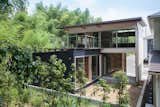Collection by Madi W
Asian Architecture
JINS Ageo Shop Renovation is a minimal space located in Tokyo, Japan, designed by Schemata Architects. The interior design was intended to emphasize the effect of exposing the skeleton of the building. New interior walls were offset from the original wall lines, finished with brick tiles usually used for exterior finishes; shelves and display furniture were designed as independent elements detached from the building. Eyewear products vary in shapes and colors, and the designers collaborated with the graphic design office KIGI to introduce visual elements in the shop so that the products and the space can relate to each other in a free and independent way.
Ogikubo House is a minimal residence located in Tokyo, Japan, designed by 2001. The two-story residence features a balcony on the upper level that is accessible via sliding glazed doors. In addition, the lower level frontage also utilizes transparent sliding doors that are slightly concealed by a concrete wall toward the front of the site. Upon entering, only a staircase going up or down is revealed, maintaining the privacy of the residents.
Yamashina House is a minimal residence located in Kyoto, Japan, designed by ALTS Design Office. The region features densely built plots that restrict usable space for gardens or green spaces. The architects wanted to create a sense of space and greenery, thus designed uniquely angled volumes to compensate. By bringing together several smaller volumes and connecting smaller spaces together, it was possible to have green areas dotted around the site, incorporating the exterior area into the building and creating a rich environment even with a limited plot.
Nakamura Residence is a minimal home located in Kochi, Japan, designed by Kidosaki Architects Studio. The frontage features a windowless concrete facade that is complemented by a series of wooden lattices that serve as the entryway. The staircase is built into the wall, and features a simple yet sophisticated aesthetic. The rear of the home features large windows in every room, maximizing natural light and outside exposure that is otherwise restricted from the front of the building.
House in Arayashiki is a minimal home located in Saga, Japan, designed by Yabashi Architect & Associates. The two-story wooden home is situated in a quiet residential neighborhood, and features a monolith facade with large windows that peer through to the other side of the building. A small terrace is accessible via sliding glazed doors that transition into the backyard.
Villa in Yoron is a minimal home located in Kagoshima, Japan, designed by CASE-REAL. Taking the view in consideration, within the low rise architectural volumes of the project, the master bedroom was kept on the ocean side to fulfill the given view, and rooms with other functions face inland. The large un-even space between these two volumes function as the main space, which become the path of the seasonal winds. The main living spaces function as a comfortable inner terrace. By installing mesh-like fixtures to the outer rims of the pent roof, a buffer zone was created to secure the safety of the interior from objects flying during the hurricanes as well as creating a comfortable opening for the panorama both opened and closed.
Hiiragi’s House is a minimal residence located in Ehime, Japan, designed by Takashi Okuno & Associates. The home features a U-shape configuration that surrounds a courtyard, providing natural light and airflow throughout the space. The home is finished using diatomaceous earth and marble powder, as well as solid wood and cellulose fiber for thermal insulation. The main living area features double-height ceilings to promote transparency between the ground floor and upper level.
House in Hikarigaoka is a minimal residence located in Tokyo, Japan, designed by upsetters architects. The building features a covered parking space on the ground floor, a luxury that is sparse in the densely populated city of Tokyo. The staircase utilizes gaps to create transparency between the levels, and to allow natural light to fill the space. In addition, the architects placed large windows at the landing of each staircase to maximize light








